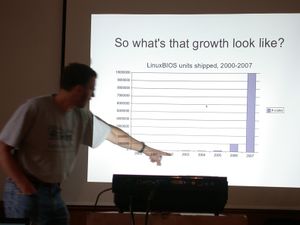Welcome to coreboot: Difference between revisions
Jump to navigation
Jump to search
mNo edit summary |
mNo edit summary |
||
| Line 6: | Line 6: | ||
It performs just a little bit of hardware initialization and then executes a so-called [[Payloads|payload]], for example a [[Linux]] kernel, [[FILO]], [[GRUB2]], [http://www.openbios.org/ OpenBIOS], [http://www.openbios.org/Open_Firmware Open Firmware], [http://www.openbios.org/SmartFirmware SmartFirmware], [http://www.gnu.org/software/gnufi/ GNUFI] (UEFI), [[Etherboot]], [[ADLO]] (for booting [http://en.wikipedia.org/wiki/Windows_2000 Windows 2000] and [http://openbsd.org/ OpenBSD]), [[Plan 9]], or [[memtest86]]. | It performs just a little bit of hardware initialization and then executes a so-called [[Payloads|payload]], for example a [[Linux]] kernel, [[FILO]], [[GRUB2]], [http://www.openbios.org/ OpenBIOS], [http://www.openbios.org/Open_Firmware Open Firmware], [http://www.openbios.org/SmartFirmware SmartFirmware], [http://www.gnu.org/software/gnufi/ GNUFI] (UEFI), [[Etherboot]], [[ADLO]] (for booting [http://en.wikipedia.org/wiki/Windows_2000 Windows 2000] and [http://openbsd.org/ OpenBSD]), [[Plan 9]], or [[memtest86]]. | ||
</div> | </div> | ||
{| cellspacing=5 cellpadding=5 border=0 valign="top" width=100% | {| cellspacing=5 cellpadding=5 border=0 valign="top" width=100% | ||
|- | |- | ||
| Line 104: | Line 99: | ||
'''<span style="font-variant:small-caps;">News</span>'''<hr /> | '''<span style="font-variant:small-caps;">News</span>'''<hr /> | ||
<small> | <small> | ||
* '''2007/02/24:''' [[News#2007.2F02.2F24_LinuxBIOS_talk_at_FOSDEM_2007|LinuxBIOS talk at FOSDEM 2007]] | * '''2007/02/24:''' [[News#2007.2F02.2F24_LinuxBIOS_talk_at_FOSDEM_2007|LinuxBIOS talk (video) at FOSDEM 2007]] | ||
* '''2007/02/09:''' [[News#2007.2F02.2F09_MSI_K9ND_Master_Series_.28MS-9282.29_supported_in_LinuxBIOS|MSI K9ND Master Series (MS-9282) support]] | * '''2007/02/09:''' [[News#2007.2F02.2F09_MSI_K9ND_Master_Series_.28MS-9282.29_supported_in_LinuxBIOS|MSI K9ND Master Series (MS-9282) support]] | ||
* '''2006/11/02:''' [[News#2006.2F11.2F02_MSI_K9SD_Master-S2R_.28MS-9185.29_supported_in_LinuxBIOS|MSI K9SD Master-S2R (MS-9185) support]] | * '''2006/11/02:''' [[News#2006.2F11.2F02_MSI_K9SD_Master-S2R_.28MS-9185.29_supported_in_LinuxBIOS|MSI K9SD Master-S2R (MS-9185) support]] | ||
Revision as of 21:11, 2 March 2007
|
LinuxBIOS is a Free Software project aimed at replacing the proprietary BIOS (firmware) you can find in most of today's computers. It performs just a little bit of hardware initialization and then executes a so-called payload, for example a Linux kernel, FILO, GRUB2, OpenBIOS, Open Firmware, SmartFirmware, GNUFI (UEFI), Etherboot, ADLO (for booting Windows 2000 and OpenBSD), Plan 9, or memtest86.
|

|





